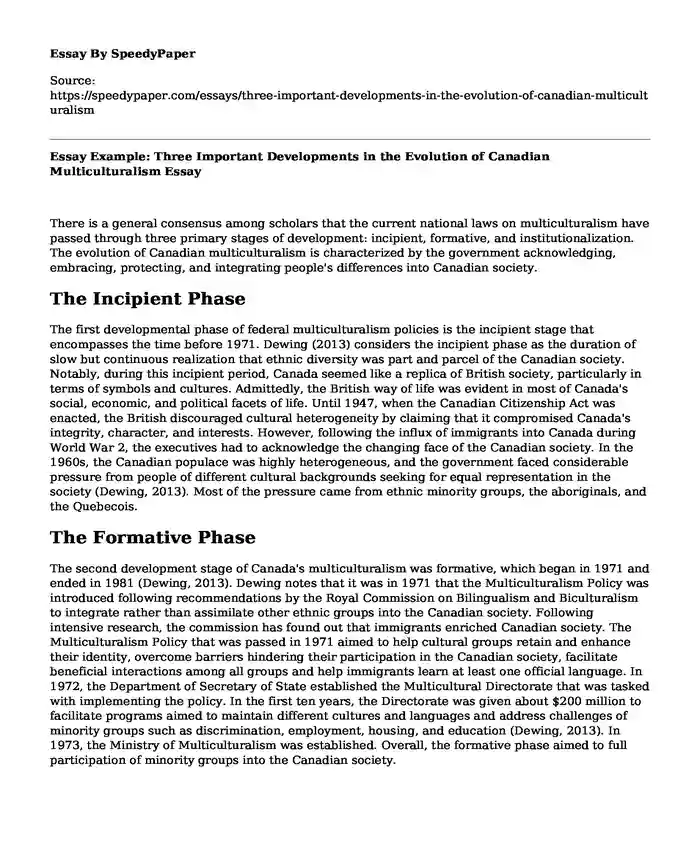
| Type of paper: | Essay |
| Categories: | Multiculturalism Diversity |
| Pages: | 3 |
| Wordcount: | 599 words |
There is a general consensus among scholars that the current national laws on multiculturalism have passed through three primary stages of development: incipient, formative, and institutionalization. The evolution of Canadian multiculturalism is characterized by the government acknowledging, embracing, protecting, and integrating people's differences into Canadian society.
The Incipient Phase
The first developmental phase of federal multiculturalism policies is the incipient stage that encompasses the time before 1971. Dewing (2013) considers the incipient phase as the duration of slow but continuous realization that ethnic diversity was part and parcel of the Canadian society. Notably, during this incipient period, Canada seemed like a replica of British society, particularly in terms of symbols and cultures. Admittedly, the British way of life was evident in most of Canada's social, economic, and political facets of life. Until 1947, when the Canadian Citizenship Act was enacted, the British discouraged cultural heterogeneity by claiming that it compromised Canada's integrity, character, and interests. However, following the influx of immigrants into Canada during World War 2, the executives had to acknowledge the changing face of the Canadian society. In the 1960s, the Canadian populace was highly heterogeneous, and the government faced considerable pressure from people of different cultural backgrounds seeking for equal representation in the society (Dewing, 2013). Most of the pressure came from ethnic minority groups, the aboriginals, and the Quebecois.
The Formative Phase
The second development stage of Canada's multiculturalism was formative, which began in 1971 and ended in 1981 (Dewing, 2013). Dewing notes that it was in 1971 that the Multiculturalism Policy was introduced following recommendations by the Royal Commission on Bilingualism and Biculturalism to integrate rather than assimilate other ethnic groups into the Canadian society. Following intensive research, the commission has found out that immigrants enriched Canadian society. The Multiculturalism Policy that was passed in 1971 aimed to help cultural groups retain and enhance their identity, overcome barriers hindering their participation in the Canadian society, facilitate beneficial interactions among all groups and help immigrants learn at least one official language. In 1972, the Department of Secretary of State established the Multicultural Directorate that was tasked with implementing the policy. In the first ten years, the Directorate was given about $200 million to facilitate programs aimed to maintain different cultures and languages and address challenges of minority groups such as discrimination, employment, housing, and education (Dewing, 2013). In 1973, the Ministry of Multiculturalism was established. Overall, the formative phase aimed to full participation of minority groups into the Canadian society.
Institutionalization Phase
The Canadian Charter of Rights and Freedoms enacted in 1982 marked the end of the formative stage and the start of the institutionalization phase that runs to-date. The 1982 Charter was the government's efforts to assert that the multicultural heritage was a part of the Canadian society and to protect the rights and privileges of the minority groups (Dewing, 2013). The Canadian Charter gave courts the power and guidelines to protect Canada's multiculturalism. More precisely, the Charter showed that all Canadian citizens have equal rights regardless of race, ethnic, color, religion, sex, ability, or age. From 1984, there were calls from different committees to introduce a multiculturalism policy that was clearer and more focused. The lobbying led to the enactment of the Canadian Multiculturalism Act of 1988 that aimed to promote cultural awareness and end discrimination (Dewing, 2013). In the same, the Canadian government officially apologized for mistreating minority groups, especially Japanese Canadians during the Second World War. By 1993, multiculturalism programs were under the national department of heritage (Dewing, 2013). Over the years, the Government of Canada has transformed multiculturalism programs and objectives to establish an integrated and socially cohesive society where the needs and interests of every Canadian are acknowledged and protected.
Cite this page
Essay Example: Three Important Developments in the Evolution of Canadian Multiculturalism. (2022, Aug 22). Retrieved from https://speedypaper.com/essays/three-important-developments-in-the-evolution-of-canadian-multiculturalism
Request Removal
If you are the original author of this essay and no longer wish to have it published on the SpeedyPaper website, please click below to request its removal:
- Asking Mr. Bill for an A, an Argumentative Essay Sample
- Shale Oil Essay Sample
- Free Essay Claiming Sir Wilfrid Laurier Is the Best Prime Minister of All Times
- Wabash Community Health Center Case
- Intensity (Consequences of problem behavior on student, peers, instructional environment):
- Essay Example on Dealing With Conflict: Understanding Styles and Strategies
- Essay Sample about Strategies and Solutions for Volkswagen's Unsustainable Project
Popular categories




